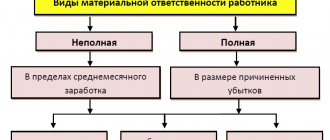Vicarious liability is a type of obligation regulated by civil law, bankruptcy law and other regulations. All of these acts are intended to regulate relations between parties engaged in commercial activities and to protect the rights of the parties by holding the perpetrators accountable for their actions.
The possibility of involving the perpetrators in this type of obligation (sub-liability) provides guarantees for the protection of the rights and interests of both individuals and legal entities.
Concept and legal regulation of joint and several liability
Joint and several liability implies the obligation of several debtors to fulfill one claim of the creditor at once. The opposite option is also possible, when one debtor repays an obligation to several creditors, but this is a special and rare case. This type of liability arises when it is impossible to divide the subject of obligations between the parties, and a group of persons is equally liable for them.
Joint and several liability should be distinguished from shared liability. An example of shared liability would be the distribution of utility debts between the owners. Each of them is liable for debts incurred within the limits of his share in the real estate and is not obliged to answer for the debts of other owners.
Joint and several liability does not imply that after paying a certain amount, calculated as dividing the debt by the number of people, the debtor is released from debt obligations. For example, if one of the debtors repays 50% of the debt, he remains liable for the remaining 50%.
With joint liability, first of all, the interests of creditors, who are endowed with a wide range of rights, are protected. Thus, creditors have the right to demand compensation for debt from all or some of them, or from a specific person. This is a fairly profitable scheme for the lender: he has a greater chance of collecting debt from several borrowers at the same time than from one of them.
For example: the amount of debt is 300 thousand rubles. divided between three contractors. One of them gave the customer 100 thousand rubles. The remaining 200 thousand rubles. the customer has the right to demand from all three contractors. Joint and several liability does not mean that the customer can demand 300 thousand rubles. from everyone.
Joint and several liability occurs taking into account the provisions of paragraph 1 of Art. 707 Civil Code, Art. 322, 323 Civil Code. Article 322 of the Civil Code distinguishes between the terms “joint and several obligations” and “liability”. Joint and several obligations arise if several persons are on the side of the debtor at the same time, and they must jointly answer to the creditors. At the same time, the creditor is not obliged to justify the choice of the person whom he prefers to hold accountable under the provisions of Art. 323 Civil Code.
Joint and several debtors have the obligation to pay off the debts as a whole , as if each debtor were the only one. The essence of a joint and several obligation is that until it is fully fulfilled, any of the debtors is obliged to fulfill it.
Subsequently, the person who has repaid the debt has the right to make claims for damages through recourse. But before that, it is obliged to satisfy the demands of creditors. The amount of recourse claims is determined by a simple formula: after payment of compensation, the amount of money spent by each person to repay the debt to creditors must be the same (based on Article 325 of the Civil Code).
Joint and several liability may arise under the provisions of a contract or law. For example, such liability of LLC participants by law arises upon its liquidation. Thus, if the value of the property of the company being closed is not enough to cover the costs of liquidating the company, then its participants bear such costs jointly from their own funds (based on paragraph 2 of Article 62 of the Civil Code).
It also arises when creating an LLC at the stage when the participants form the authorized capital of the company . It is necessary in order to guarantee creditors that the legal entity will be able to pay them for its obligations. According to established practice: the larger the size of the authorized capital, the greater the trust in this legal entity. In case of payment of the authorized capital, the participants are not liable for the debts of the company. But if someone has not paid for their share in the authorized capital, then the participants are jointly and severally liable to the extent of the unpaid share under clause 1 of Art. 87 Civil Code.
The joint liability of the heirs occurs according to the norms of paragraph 1 of Art. 1175 of the Civil Code. It says here that all heirs are liable for the debts of the testator within the value of the inherited property (for example, if the value of the inherited house is 500 thousand rubles, and the amount of debt obligations is 700 thousand rubles, then two heirs are liable for debts within 500 thousand .r., and this amount is divided into two).
Spouses are also jointly and severally liable for the family's debt obligations under clause 2 of Art. 45 of the Family Code. For example, they jointly bear the responsibility for repaying a loan received for family purposes.
Joint and several liability in case of an accident under clause 3 of Art. 1079 of the Civil Code occurs between car owners if passengers or property of third parties were damaged due to an accident.
In paragraph 2 of Art. 322 of the Civil Code, joint and several liability applies to debtors associated with business.
Today, most loan agreements include requirements for the possibility of holding the guarantor jointly and severally liable. This is often not taken into account by guarantors, and they take on increased risks.
With this form of agreement, the bank can present its claims to both the main debtor and the guarantor.
Bankruptcy initiated by the Federal Tax Service
The worst option for the debtor is to initiate the procedure by authorized bodies (the prosecutor's office or the Federal Tax Service). The Bankruptcy Law has given the Federal Tax Service special rights that allow filing an application without a judicial act that has entered into force. Unlike ordinary creditors, it is enough for the Federal Tax Service to formalize a decision to collect the debt from the taxpayer’s funds or property. And then, after 30 days, the Federal Tax Service files a lawsuit.
It should be noted that the Federal Tax Service files a claim only if it is sure that the debtor has property. This is due to the fact that the courts require that the facts about the existence of property be established so that there is someone to pay the legal costs and the work of the insolvency practitioners. If there is no information about the property, then the inspection will make every effort to find it, and will make inquiries to Rosreestr, bailiffs, the traffic police and other government bodies. The same applies to subsidiary liability - tax authorities will collect evidence on the beneficiaries, and only then will they file a bankruptcy claim.
Concept and legal regulation of subsidiary liability
Vicarious liability is translated as reserve or auxiliary. This is a way to protect creditor interests in cases where basic debt collection measures have not brought results.
Vicarious liability is an additional type of civil liability, which is aimed at satisfying creditor claims at the expense of third parties when it is impossible for the main debtor to repay the obligations.
For example, SROs compensate on a subsidiary basis for damage caused by their members only if they do not have their own resources for this. The state pays compensation for harm to health caused to a citizen in a municipal hospital if the medical institution does not have the means to do so.
The general rules for bringing to subsidiary liability are prescribed in Art. 399 Civil Code. This most important regulator of civil relations contains more than 15 articles on issues of subsidiary liability. In particular, Art. 677, 123.3, 60.1 Civil Code of the Russian Federation.
To bring a person to subsidiary liability, it is necessary to follow a certain procedure:
- The creditor demands repayment of the debt from the individual or legal entity who is the main debtor.
- Only if the main debtor refuses to pay within the framework of the presented demand or does not provide a response to the received request within the established time frame, then the creditor has the right to collect the debt from the subsidiary debtor.
- When a subsidiary debtor receives demands from a creditor, the former is obliged to notify the principal debtor about this . Otherwise, he may lose the right to claim repayment of the debt owed to him by way of recourse. According to paragraph 53 of the Resolution of the Plenum of the Russian Federation of 1996 No. 6, the creditor approaches the debtor exclusively in writing and is obliged to preserve evidence of the written request.
Vicarious liability can arise on a contractual and non-contractual basis. In the latter case, a person may be forced to pay off debts without an appropriate agreement. For example, the management of a legal entity is held accountable for bringing the company to bankruptcy.
A typical example of contractual liability is surety agreements when applying for a loan, in which the guarantor assumes such responsibilities. The guarantor is involved in repaying the debt for the main debtor if he was unable to fulfill his financial obligations under the loan.
Another example of subsidiary contractual liability is the conclusion of a commercial concession agreement. The parties to such an agreement are liable if harm is caused to the copyright holder by secondary users.
Civil law provides for the emergence of subsidiary liability for any participant in legal entities who occupies a leadership position or can influence decision-making, control them for 2 years before bankruptcy or reorganization of the company.
A participant brought to subsidiary liability is liable for the debt obligations incurred with all property. A person can be held accountable if two basic conditions are met:
- If the value of the property of an organization of any form of ownership is lower than the amount of debt claims of creditors.
- If the fault of a subsidiary debtor has been proven in causing damage to creditors.
In particular, as part of a bankruptcy case, the management or founders of a legal entity may be held vicariously liable if the manager proves their guilt in fictitious or deliberate bankruptcy. Fictitious bankruptcy involves distorting financial statements and hiding assets to create the appearance of financial insolvency. Intentional bankruptcy consists of taking specific actions to worsen the financial condition of a legal entity.
Another basis for bringing to subsidiary liability is failure to submit a bankruptcy application within the required time frame if there are grounds for this.
The circle of persons who can apply for subsidiary liability is quite broad. These may be managers, law enforcement agencies, creditors, and employees of the debtor.
In a number of cases, by agreement between the parties or by law, subsidiary liability is replaced by joint and several liability.
conclusions
Vicarious liability is an additional guarantee to creditors and the state that debts will be repaid and those responsible will not escape responsibility. That is why the state is waging a tough fight against illegal schemes for getting rid of obligations. Today it will be more expensive. It is more profitable to work transparently, to be a conscientious entrepreneur, and not to expose yourself to personal property liability.
Have such situations ever happened in your life? Be sure to write to us in the comments and don’t forget to rate the article :)
Rate this article:
[Total: 3 Average: 5/5] (Article Rating: 5 out of 5)
Author of the article Victoria Pchelinova Freelancer, creative and business
Who can create consolidated groups of taxpayers?
Part one of the Tax Code of the Russian Federation was supplemented by Ch. 3.1 “Consolidated group of taxpayers.” Let's consider the basic principles of creating and functioning of a consolidated group of taxpayers.
Purpose of creation. The purpose of creating a consolidated group is to calculate and pay corporate income tax, taking into account the total financial result of the economic activities of these taxpayers. In this case, a new legal entity is not created.
Conditions of creation. The Tax Code of the Russian Federation provides for two main conditions for creating a consolidated group of taxpayers:
- the voluntary nature of participation in the group;
- formation of a group on the basis of an agreement and on the terms provided for by the Tax Code of the Russian Federation.
Creation criteria. Tax legislation establishes a number of restrictions on the creation of consolidated groups. At the same time, the conditions that the participants of the consolidated group of taxpayers must comply with must be fulfilled throughout the entire period of validity of the agreement on the creation of the specified group, unless otherwise provided by the Tax Code of the Russian Federation. A consolidated group of taxpayers must be created for at least two tax periods for corporate income tax, that is, for two calendar years. Moreover, it can be created for either a definite or an indefinite period, which is established by the agreement.








